Diffusion of Electricity Consumption Practices in Mexico
Abstract
:1. Introduction
2. Inequality and Energy Sustainability
3. Electrical Appliances Ownership
4. Research Methodology
5. Results
5.1. Trends in Appliances Ownership
5.2. Latent Profiles: Identifying Differences in Appliance Use
6. Conclusions
Acknowledgments
Author Contributions
Conflicts of Interest
Appendix A
| Model | LL | BIC | AIC | Npar | Class.Err. |
|---|---|---|---|---|---|
| 1-Class | −318,123 | 636,270 | 636,250 | 2 | 0.00% |
| 2-Classes | −260,394 | 521,071 | 520,833 | 23 | 7.40% |
| 3-Classes | −228,956 | 458,455 | 458,001 | 44 | 11.68% |
| 4-Classes | −217,093 | 434,986 | 434,315 | 65 | 15.97% |
| 5-Classes | −211,992 | 425,044 | 424,157 | 86 | 19.61% |
| 6-Classes | −211,211 | 423,739 | 422,635 | 107 | 20.42% |
| 7-Classes | −208,994 | 419,564 | 418,244 | 128 | 23.86% |
| 8-Classes | −208,724 | 419,283 | 417,746 | 149 | 25.93% |
| Year | Chi2 Estimation | Degrees of Freedom | p-Value |
|---|---|---|---|
| 1992 | 5636.9 | 4 | 0.000 |
| 1994 | 6930.8 | 4 | 0.000 |
| 1996 | 7201 | 4 | 0.000 |
| 1998 | 5643.5 | 4 | 0.000 |
| 2000 | 5096.1 | 4 | 0.000 |
| 2002 | 8762.1 | 4 | 0.000 |
| 2004 | 11,632.8 | 4 | 0.000 |
| 2005 | 11,904.1 | 4 | 0.000 |
| 2006 | 10,473.1 | 4 | 0.000 |
| 2008 | 13,641.6 | 4 | 0.000 |
| 2010 | 12,685 | 4 | 0.000 |
| 2012 | 4077.5 | 4 | 0.000 |
| 2014 | 7301.8 | 4 | 0.000 |
| Year | Chi2 Estimation | Degrees of Freedom | p-Value |
|---|---|---|---|
| 1992 | 2836.1 | 4 | 0.000 |
| 1994 | 3416.4 | 4 | 0.000 |
| 1996 | 3995.3 | 4 | 0.000 |
| 1998 | 2514.1 | 4 | 0.000 |
| 2000 | 2023.5 | 4 | 0.000 |
| 2002 | 3863.9 | 4 | 0.000 |
| 2004 | 4514.9 | 4 | 0.000 |
| 2005 | 4967.3 | 4 | 0.000 |
| 2006 | 3623.4 | 4 | 0.000 |
| 2008 | 3818.9 | 4 | 0.000 |
| 2010 | 3617.9 | 4 | 0.000 |
| 2012 | 1170 | 4 | 0.000 |
| 2014 | 2057.8 | 4 | 0.000 |
| High | Medium High | Medium | Low | Minimum | Total | |
|---|---|---|---|---|---|---|
| Total probabilities | 0.08 | 0.27 | 0.37 | 0.21 | 0.07 | 1.00 |
| Indicator | - | |||||
| Appliance index | - | |||||
| 0–0.900 | 0.00 | 0.00 | 0.09 | 0.59 | 0.32 | 1.00 |
| 1–1.400 | 0.00 | 0.05 | 0.57 | 0.38 | - | 1.00 |
| 1.500–1.800 | 0.01 | 0.18 | 0.75 | 0.06 | - | 1.00 |
| 1.900–2.400 | 0.03 | 0.47 | 0.49 | 0.00 | - | 1.00 |
| 2.500–22.70 | 0.34 | 0.61 | 0.05 | - | - | 1.00 |
| Covariates | - | |||||
| Logarithm of current income | - | |||||
| Quintile 1 | 0.00 | 0.03 | 0.28 | 0.45 | 0.24 | 1.00 |
| Quintile 2 | 0.01 | 0.14 | 0.51 | 0.29 | 0.06 | 1.00 |
| Quintile 3 | 0.03 | 0.28 | 0.50 | 0.16 | 0.03 | 1.00 |
| Quintile 4 | 0.08 | 0.43 | 0.38 | 0.10 | 0.02 | 1.00 |
| Quintile 5 | 0.28 | 0.46 | 0.20 | 0.05 | 0.01 | 1.00 |
| Flooring construction materials | - | |||||
| Bare earth | 0.00 | 0.01 | 0.13 | 0.43 | 0.43 | 1.00 |
| Cement or firm | 0.02 | 0.17 | 0.48 | 0.29 | 0.05 | 1.00 |
| Wood, tile or other coverings | 0.19 | 0.48 | 0.29 | 0.04 | 0.01 | 1.00 |
| Rooms | - | |||||
| 1 | 0.00 | 0.03 | 0.31 | 0.44 | 0.22 | 1.00 |
| 2 | 0.01 | 0.15 | 0.46 | 0.30 | 0.08 | 1.00 |
| 3 | 0.04 | 0.34 | 0.46 | 0.14 | 0.02 | 1.00 |
| 4 | 0.12 | 0.47 | 0.34 | 0.06 | 0.01 | 1.00 |
| 5+ | 0.35 | 0.45 | 0.17 | 0.02 | 0.00 | 1.00 |
| Type of household | - | |||||
| Single household unit | 0.02 | 0.13 | 0.35 | 0.34 | 0.16 | 1.00 |
| Households without a family core | 0.21 | 0.00 | 0.67 | - | 0.12 | 1.00 |
| Couples without kids | 0.05 | 0.24 | 0.41 | 0.22 | 0.09 | 1.00 |
| Couples with kids | 0.09 | 0.28 | 0.37 | 0.20 | 0.06 | 1.00 |
| Single parent households with kids | 0.07 | 0.26 | 0.40 | 0.21 | 0.05 | 1.00 |
| Extended households | 0.09 | 0.30 | 0.38 | 0.18 | 0.05 | 1.00 |
| Composed households | 0.09 | 0.59 | - | 0.32 | - | 1.00 |
| Age | - | |||||
| 12–22 | 0.03 | 0.20 | 0.41 | 0.28 | 0.08 | 1.00 |
| 23–30 | 0.07 | 0.29 | 0.38 | 0.20 | 0.06 | 1.00 |
| 31–38 | 0.11 | 0.31 | 0.36 | 0.17 | 0.05 | 1.00 |
| 39–50 | 0.11 | 0.30 | 0.35 | 0.18 | 0.06 | 1.00 |
| 51–86 | 0.07 | 0.24 | 0.37 | 0.22 | 0.10 | 1.00 |
| Education of the HH head | - | |||||
| No education | 0.01 | 0.07 | 0.28 | 0.39 | 0.25 | 1.00 |
| Primary education | 0.03 | 0.19 | 0.42 | 0.28 | 0.08 | 1.00 |
| Some secondary education | 0.05 | 0.30 | 0.47 | 0.16 | 0.02 | 1.00 |
| Higher education | 0.22 | 0.46 | 0.27 | 0.04 | 0.00 | 1.00 |
| Sex of the HH head | - | |||||
| Male | 0.08 | 0.27 | 0.36 | 0.21 | 0.07 | 1.00 |
| Female | 0.07 | 0.26 | 0.41 | 0.21 | 0.05 | 1.00 |
| Location | - | |||||
| Urban | 0.1045 | 0.3365 | 0.395 | 0.1466 | 0.0174 | 1.00 |
| Rural | 0.0127 | 0.0934 | 0.3238 | 0.3712 | 0.1988 | 1.00 |
| HH size | - | |||||
| 1–2 | 0.05 | 0.21 | 0.39 | 0.25 | 0.11 | 1.00 |
| 3 | 0.08 | 0.30 | 0.39 | 0.18 | 0.05 | 1.00 |
| 4 | 0.10 | 0.32 | 0.38 | 0.17 | 0.04 | 1.00 |
| 5 | 0.10 | 0.29 | 0.38 | 0.18 | 0.05 | 1.00 |
| 6+ | 0.07 | 0.23 | 0.34 | 0.26 | 0.10 | 1.00 |
| Having remittances | - | |||||
| No | 0.08 | 0.27 | 0.37 | 0.21 | 0.07 | 1.00 |
| Yes | 0.04 | 0.24 | 0.47 | 0.21 | 0.03 | 1.00 |
| Region | - | |||||
| Northwest | 0.11 | 0.34 | 0.38 | 0.14 | 0.03 | 1.00 |
| Central | 0.07 | 0.26 | 0.39 | 0.23 | 0.05 | 1.00 |
| Northeast | 0.10 | 0.32 | 0.39 | 0.15 | 0.05 | 1.00 |
| Central-west | 0.08 | 0.28 | 0.39 | 0.20 | 0.05 | 1.00 |
| South-Southeast | 0.06 | 0.21 | 0.33 | 0.26 | 0.13 | 1.00 |
| Year | ||||||
| 1992 | 0.0462 | 0.1895 | 0.3342 | 0.2999 | 0.1301 | 1.00 |
| 1994 | 0.0565 | 0.2121 | 0.3334 | 0.282 | 0.116 | 1.00 |
| 1996 | 0.045 | 0.2061 | 0.3624 | 0.2831 | 0.1033 | 1.00 |
| 1998 | 0.0547 | 0.2261 | 0.3642 | 0.2521 | 0.1029 | 1.00 |
| 2000 | 0.0655 | 0.2431 | 0.3779 | 0.2378 | 0.0756 | 1.00 |
| 2002 | 0.0632 | 0.2509 | 0.3813 | 0.2134 | 0.0911 | 1.00 |
| 2004 | 0.1042 | 0.3098 | 0.3588 | 0.1628 | 0.0644 | 1.00 |
| 2005 | 0.0957 | 0.294 | 0.3559 | 0.188 | 0.0664 | 1.00 |
| 2006 | 0.1016 | 0.3036 | 0.3588 | 0.1781 | 0.0579 | 1.00 |
| 2008 | 0.105 | 0.2985 | 0.3793 | 0.1754 | 0.0418 | 1.00 |
| 2010 | 0.0804 | 0.2787 | 0.3933 | 0.2002 | 0.0474 | 1.00 |
| 2012 | 0.0686 | 0.2542 | 0.3966 | 0.2228 | 0.0578 | 1.00 |
| 2014 | 0.0548 | 0.2656 | 0.445 | 0.1996 | 0.035 | 1.00 |
| High | Medium High | Medium | Low | Minimum | |
|---|---|---|---|---|---|
| Cluster Size | 0.08 | 0.27 | 0.37 | 0.21 | 0.07 |
| Indicator | |||||
| Appliance index | |||||
| Mean | 3.64 | 2.42 | 1.64 | 0.87 | 0.18 |
| Covariates | |||||
| Logarithm of current income | |||||
| Quintile 1 | 0.00 | 0.03 | 0.15 | 0.43 | 0.68 |
| Quintile 2 | 0.02 | 0.10 | 0.27 | 0.27 | 0.16 |
| Quintile 3 | 0.06 | 0.21 | 0.27 | 0.15 | 0.08 |
| Quintile 4 | 0.20 | 0.32 | 0.20 | 0.09 | 0.05 |
| Quintile 5 | 0.71 | 0.34 | 0.11 | 0.05 | 0.02 |
| Total | 1.00 | 1.00 | 1.00 | 1.00 | 1.00 |
| Mean | 9.97 | 9.29 | 8.69 | 8.17 | 7.69 |
| Flooring construction materials | |||||
| Bare earth | 0.00 | 0.00 | 0.03 | 0.19 | 0.59 |
| Cement or firm | 0.12 | 0.34 | 0.68 | 0.73 | 0.38 |
| Wood, tile or other coverings | 0.88 | 0.66 | 0.29 | 0.08 | 0.03 |
| Total | 1.00 | 1.00 | 1.00 | 1.00 | 1.00 |
| Rooms | |||||
| 1 | 0.00 | 0.03 | 0.16 | 0.40 | 0.62 |
| 2 | 0.03 | 0.14 | 0.31 | 0.36 | 0.28 |
| 3 | 0.14 | 0.33 | 0.32 | 0.17 | 0.07 |
| 4 | 0.25 | 0.29 | 0.15 | 0.05 | 0.02 |
| 5+ | 0.57 | 0.22 | 0.06 | 0.01 | 0.00 |
| Total | 1.00 | 1.00 | 1.00 | 1.00 | 1.00 |
| Mean | 5.07 | 3.67 | 2.67 | 1.92 | 1.50 |
| Type of household | |||||
| Single household unit | 0.02 | 0.04 | 0.08 | 0.13 | 0.19 |
| Households without a family core | 0.01 | - | 0.01 | - | 0.01 |
| Couples without kids | 0.06 | 0.08 | 0.09 | 0.09 | 0.11 |
| Couples + kids | 0.55 | 0.51 | 0.48 | 0.46 | 0.43 |
| Single parent households + kids | 0.08 | 0.10 | 0.11 | 0.10 | 0.07 |
| Extended households | 0.27 | 0.26 | 0.24 | 0.21 | 0.19 |
| Composed households | 0.01 | 0.01 | - | 0.01 | - |
| Total | 1.00 | 1.00 | 1.00 | 1.00 | 1.00 |
| Age of the HH head | |||||
| 12–22 | 0.08 | 0.16 | 0.23 | 0.27 | 0.23 |
| 23–30 | 0.19 | 0.21 | 0.20 | 0.19 | 0.16 |
| 31–38 | 0.26 | 0.22 | 0.18 | 0.15 | 0.13 |
| 39–50 | 0.29 | 0.23 | 0.20 | 0.18 | 0.19 |
| 51–86 | 0.18 | 0.18 | 0.19 | 0.21 | 0.29 |
| Total | 1.00 | 1.00 | 1.00 | 1.00 | 1.00 |
| Mean | 50.07 | 47.78 | 46.59 | 46.18 | 49.87 |
| Education of the HH head | |||||
| No education | 0.01 | 0.03 | 0.10 | 0.24 | 0.45 |
| Elmentary education | 0.13 | 0.30 | 0.47 | 0.56 | 0.48 |
| Some secondary education | 0.12 | 0.22 | 0.25 | 0.15 | 0.05 |
| Tertiary | 0.73 | 0.45 | 0.19 | 0.05 | 0.02 |
| Total | 1.00 | 1.00 | 1.00 | 1.00 | 1.00 |
| Sex of the HH head | |||||
| Male | 0.82 | 0.78 | 0.76 | 0.79 | 0.83 |
| Female | 0.18 | 0.22 | 0.24 | 0.21 | 0.17 |
| Total | 1.00 | 1.00 | 1.00 | 1.00 | 1.00 |
| Location | |||||
| Urban | 0.95 | 0.90 | 0.76 | 0.50 | 0.18 |
| Rural | 0.05 | 0.10 | 0.25 | 0.50 | 0.82 |
| Total | 1.00 | 1.00 | 1.00 | 1.00 | 1.00 |
| HH size | |||||
| 1–2 | 0.14 | 0.18 | 0.23 | 0.27 | 0.35 |
| 3 | 0.18 | 0.20 | 0.18 | 0.15 | 0.11 |
| 4 | 0.28 | 0.26 | 0.22 | 0.17 | 0.12 |
| 5 | 0.22 | 0.19 | 0.17 | 0.15 | 0.12 |
| 6+ | 0.19 | 0.18 | 0.19 | 0.26 | 0.29 |
| Total | 1.00 | 1.00 | 1.00 | 1.00 | 1.00 |
| Mean | 4.34 | 4.16 | 4.03 | 4.20 | 4.15 |
| Having remittances | |||||
| No | 0.97 | 0.95 | 0.93 | 0.95 | 0.97 |
| Yes | 0.03 | 0.05 | 0.07 | 0.05 | 0.03 |
| Total | 1.00 | 1.00 | 1.00 | 1.00 | 1.00 |
| Region | |||||
| Northwest | 0.14 | 0.13 | 0.10 | 0.07 | 0.04 |
| Central | 0.23 | 0.24 | 0.26 | 0.26 | 0.19 |
| Northeast | 0.18 | 0.17 | 0.15 | 0.10 | 0.10 |
| Central-west | 0.24 | 0.25 | 0.25 | 0.23 | 0.18 |
| South-Southeast | 0.21 | 0.21 | 0.24 | 0.34 | 0.49 |
| Total | 1.00 | 1.00 | 1.00 | 1.00 | 1.00 |
| Year | |||||
| 1992 | 0.03 | 0.03 | 0.04 | 0.07 | 0.09 |
| 1994 | 0.04 | 0.04 | 0.05 | 0.08 | 0.10 |
| 1996 | 0.04 | 0.05 | 0.06 | 0.08 | 0.09 |
| 1998 | 0.03 | 0.04 | 0.05 | 0.06 | 0.07 |
| 2000 | 0.04 | 0.04 | 0.04 | 0.05 | 0.05 |
| 2002 | 0.06 | 0.07 | 0.08 | 0.08 | 0.10 |
| 2004 | 0.13 | 0.11 | 0.10 | 0.08 | 0.09 |
| 2005 | 0.12 | 0.11 | 0.10 | 0.09 | 0.10 |
| 2006 | 0.12 | 0.10 | 0.09 | 0.08 | 0.08 |
| 2008 | 0.17 | 0.14 | 0.13 | 0.11 | 0.08 |
| 2010 | 0.12 | 0.13 | 0.13 | 0.12 | 0.08 |
| 2012 | 0.04 | 0.04 | 0.04 | 0.04 | 0.03 |
| 2014 | 0.06 | 0.09 | 0.10 | 0.08 | 0.04 |
| Total | 1.00 | 1.00 | 1.00 | 1.00 | 1.00 |
| High | Medium-High | Medium | Low | Minimum | Total | |
|---|---|---|---|---|---|---|
| Education level | ||||||
| 1992 | ||||||
| No education | 1.38 | 5.00 | 12.78 | 33.30 | 58.15 | 17.90 |
| Elementary | 12.54 | 35.78 | 56.82 | 59.44 | 39.95 | 48.36 |
| Secondary | 10.39 | 19.88 | 21.19 | 6.09 | 1.82 | 15.60 |
| Tertiary | 75.69 | 39.34 | 9.21 | 1.16 | 0.09 | 18.14 |
| Total | 100.00 | 100.00 | 100.00 | 100.00 | 100.00 | 100.00 |
| 2014 | ||||||
| No education | 0.56 | 1.46 | 6.10 | 23.71 | 57.64 | 7.96 |
| Elementary | 4.06 | 18.24 | 40.35 | 54.24 | 37.68 | 33.76 |
| Secondary | 6.19 | 21.48 | 31.31 | 16.85 | 3.13 | 24.30 |
| Tertiary | 89.19 | 58.82 | 22.23 | 5.19 | 1.55 | 33.98 |
| Total | 100.00 | 100.00 | 100.00 | 100.00 | 100.00 | 100.00 |
| Sex of the head | ||||||
| 1992 | ||||||
| Male | 89.21 | 85.14 | 84.57 | 86.77 | 88.56 | 85.75 |
| Female | 10.79 | 14.86 | 15.43 | 13.23 | 11.44 | 14.25 |
| Total | 100.00 | 100.00 | 100.00 | 100.00 | 100.00 | 100.00 |
| 2014 | ||||||
| Male | 80.42 | 75.77 | 72.98 | 72.78 | 80.17 | 74.31 |
| Female | 19.58 | 24.23 | 27.02 | 27.22 | 19.83 | 25.69 |
| Total | 100.00 | 100.00 | 100.00 | 100.00 | 100.00 | 100.00 |
| Location of the residence | ||||||
| 1992 | ||||||
| Urban | 99.34 | 96.67 | 86.47 | 53.33 | 2.62 | 76.51 |
| Rural | 0.66 | 3.33 | 13.53 | 46.67 | 97.38 | 23.49 |
| Total | 100.00 | 100.00 | 100.00 | 100.00 | 100.00 | 100.00 |
| 2014 | ||||||
| Urban | 97.91 | 94.81 | 79.18 | 41.80 | 6.93 | 78.00 |
| Rural | 2.09 | 5.19 | 20.82 | 58.20 | 93.07 | 22.00 |
| Total | 100.00 | 100.00 | 100.00 | 100.00 | 100.00 | 100.00 |
| Age | ||||||
| 1992 | 47.51 | 45.39 | 43.20 | 42.73 | 46.85 | 44.16 |
| 2014 | 53.26 | 49.42 | 47.93 | 48.06 | 57.04 | 48.83 |
| Household size | ||||||
| 1992 | 5.01 | 4.69 | 4.50 | 4.96 | 4.87 | 4.70 |
| 2014 | 4.02 | 3.97 | 3.75 | 3.50 | 3.20 | 3.79 |
| Quintile 1 | Quintile 2 | Quintile 3 | Quintile 4 | Quintile 5 | Total | |
|---|---|---|---|---|---|---|
| Education level | ||||||
| 1992 | ||||||
| No education | 35.50 | 22.39 | 18.22 | 14.11 | 6.65 | 17.91 |
| Elementary | 58.80 | 60.28 | 53.98 | 48.87 | 27.43 | 48.22 |
| Secondary | 5.00 | 12.94 | 19.11 | 19.43 | 18.74 | 15.78 |
| Tertiary | 0.70 | 4.39 | 8.69 | 17.59 | 47.18 | 18.09 |
| Total | 100.00 | 100.00 | 100.00 | 100.00 | 100.00 | 100.00 |
| 2014 | ||||||
| No education | 14.70 | 9.78 | 7.77 | 5.89 | 2.08 | 7.96 |
| Elementary | 49.12 | 41.55 | 36.38 | 29.26 | 13.90 | 33.76 |
| Secondary | 26.38 | 29.30 | 28.62 | 24.09 | 13.83 | 24.30 |
| Tertiary | 9.81 | 19.37 | 27.24 | 40.75 | 70.20 | 33.98 |
| Total | 100.00 | 100.00 | 100.00 | 100.00 | 100.00 | 100.00 |
| Sex of the head | ||||||
| 1992 | ||||||
| Male | 92.51 | 89.61 | 86.30 | 83.49 | 80.33 | 85.78 |
| Female | 7.49 | 10.39 | 13.70 | 16.51 | 19.67 | 14.22 |
| Total | 100.00 | 100.00 | 100.00 | 100.00 | 100.00 | 100.00 |
| 2014 | ||||||
| Male | 77.64 | 76.90 | 74.91 | 71.74 | 70.62 | 74.31 |
| Female | 22.36 | 23.10 | 25.09 | 28.26 | 29.38 | 25.69 |
| Total | 100.00 | 100.00 | 100.00 | 100.00 | 100.00 | 100.00 |
| Location of the residence | ||||||
| 1992 | ||||||
| Urban | 37.71 | 68.94 | 81.10 | 86.35 | 94.25 | 76.55 |
| Rural | 62.29 | 31.06 | 18.90 | 13.65 | 5.75 | 23.45 |
| Total | 100.00 | 100.00 | 100.00 | 100.00 | 100.00 | 100.00 |
| 2014 | ||||||
| Urban | 53.73 | 73.78 | 80.71 | 87.63 | 93.12 | 78.01 |
| Rural | 46.27 | 26.22 | 19.29 | 12.37 | 6.88 | 21.99 |
| Total | 100.00 | 100.00 | 100.00 | 100.00 | 100.00 | 100.00 |
| Age | ||||||
| 1992 | 42.81 | 43.16 | 43.95 | 44.63 | 44.73 | 43.97 |
| 2014 | 45.88 | 47.91 | 49.05 | 50.50 | 50.69 | 48.83 |
| Household size | ||||||
| 1992 | 6.39 | 5.47 | 4.84 | 4.11 | 3.43 | 4.70 |
| 2014 | 4.99 | 4.28 | 3.85 | 3.28 | 2.61 | 3.79 |
References
- Akenji, Lewis, and Magnus Bengtsson. 2014. Making Sustainable Consumption and Production the Core of Sustainable Development Goals. Sustainability 6: 513–29. [Google Scholar] [CrossRef]
- Alberini, Anna, Will Gans, and Daniel Velez-Lopez. 2011. Residential consumption of gas and electricity in the U.S.: The role of prices and income. Energy Economics 33: 870–81. [Google Scholar] [CrossRef]
- Banxico. 2016. Estadísticas [WWW Document]. Available online: http://www.banxico.org.mx/estadisticas/index.html (accessed on 5 March 2016).
- Barber, Jeffrey. 2003. Production, Consumption and the World Summit on Sustainable Development. Environment, Development and Sustainability 5: 63–93. [Google Scholar] [CrossRef]
- Belaïd, Fateh. 2016. Understanding the spectrum of domestic energy consumption: Empirical evidence from France. Energy Policy 92: 220–33. [Google Scholar] [CrossRef]
- Bizikova, Livia, László Pintér, Gabriel A. Huppé, Heinz Schandl, Charles Arden-Clarke, Sandra Averous, Alice Mansion, and Clementine O’Connor. 2015. Sustainable Consumption and Production Indicators for the Future SDGs. UNEP Discussion Paper. Paris: United Nations Environment Programme. [Google Scholar]
- Blázquez, Leticia, Nina Boogen, and Massimo Filippini. 2013. Residential electricity demand in Spain: New empirical evidence using aggregate data. Energy Economics 36: 648–57. [Google Scholar] [CrossRef]
- Boogen, Nina, Souvik Datta, and Massimo Filippini. 2014. Going beyond Tradition: Estimating Residential Electricity Demand Using an Appliance Index and Energy Services. SSRN Scholarly Paper No. ID 2466015. Rochester: Social Science Research Network. [Google Scholar]
- Campos-Vázquez, Raymundo, Gerardo Esquivel, and Nora Lustig. 2014. The Rise and Fall of Income Inequality in Mexico, 1989–2010. In Falling Inequality in Latin America: Policy Changes and Lessons. Edited by Giovanni Andrea Cornia. Oxford: Oxford University Press, pp. 140–63. [Google Scholar]
- Cayla, Jean-Michel, Nadia Maizi, and Christophe Marchand. 2011. The role of income in energy consumption behaviour: Evidence from French households data. Energy Policy 39: 7874–83. [Google Scholar] [CrossRef]
- CEPAL. 2016. CEPALSTAT: Estadísticas e Indicadores Demográficos y Sociales. América Latina [WWW Document]. Available online: http://websie.eclac.cl/infest/ajax/cepalstat.asp?carpeta=estadisticas (accessed on 4 April 2016).
- Coneval. 2014. Evolución de la Población en Pobreza en Materia de Ingresos, 1992–2014 [WWW Document]. Available online: http://www.coneval.org.mx/Medicion/EDP/PublishingImages/Evolucion_ingresos/EVOL_POBREZA_INGRESOS_92-14_gr.jpg (accessed on 9 June 2016).
- Dergiades, Theologos, and Lefteris Tsoulfidis. 2008. Estimating residential demand for electricity in the United States, 1965–2006. Energy Economics 30: 2722–30. [Google Scholar] [CrossRef]
- Dergiades, Theologos, and Lefteris Tsoulfidis. 2011. Revisiting residential demand for electricity in Greece: New evidence from the ARDL approach to cointegration analysis. Empirical Economics 41: 511–31. [Google Scholar] [CrossRef]
- EIA. 2017. International Energy Outlook 2017; Washington: International U.S. Energy Information Administration, September 14. Available online: https://www.eia.gov/outlooks/ieo/ (accessed on 23 November 2017).
- Esquivel, Gerardo. 2011. The dynamics of income inequality in Mexico since NAFTA. Economia 12: 155–79. [Google Scholar] [CrossRef]
- Fischer, Corinna. 2008. Feedback on household electricity consumption: A tool for saving energy? Energy Efficiency 1: 79–104. [Google Scholar] [CrossRef]
- Fisher, Franklin M., and Carl Keysen. 1962. A Study in Econometrics: The Demand for Electricity in the United States. Amsterdam: North-Holland Pub. Co. [Google Scholar]
- Greening, Lorna A., and Hann Tarn Jeng. 1994. Lifecycle analysis of gasoline expenditure patterns. Energy Economics 16: 217–28. [Google Scholar] [CrossRef]
- Greening, Lorna A., David L. Greene, and Carmen Difiglio. 2000. Energy efficiency and consumption—The rebound effect—A survey. Energy Policy 28: 389–401. [Google Scholar] [CrossRef]
- IEA. 2015. World Energy Outlook 2015. Paris: OECD. [Google Scholar]
- IEA. 2016. Mexico Energy Outlook. Paris: OECD. [Google Scholar]
- Jensen, Jesper Ole. 2008. Measuring consumption in households: Interpretations and strategies. Ecological Economics 68: 353–61. [Google Scholar] [CrossRef]
- Jones, Rory V., Alba Fuertes, and Kevin J. Lomas. 2015. The socio-economic, dwelling and appliance related factors affecting electricity consumption in domestic buildings. Renewable and Sustainable Energy Reviews 43: 901–17. [Google Scholar] [CrossRef] [Green Version]
- Kavgic, Miroslava, Anna Mavrogianni, Dejan Mumovic, Alex Summerfield, Zarko Stevanovic, and Maja Djurovic-Petrovic. 2010. A review of bottom-up building stock models for energy consumption in the residential sector. Building and Environment 45: 1683–97. [Google Scholar] [CrossRef]
- Lenzen, Manfred, Mette Wier, Claude Cohen, Hitoshi Hayami, Shonali Pachauri, and Roberto Schaeffer. 2006. A comparative multivariate analysis of household energy requirements in Australia, Brazil, Denmark, India and Japan. Energy 31: 181–207. [Google Scholar] [CrossRef]
- Lévy, Jean-Pierre, and Fateh Belaïd. 2017. The determinants of domestic energy consumption in France: Energy modes, habitat, households and life cycles. Renewable and Sustainable Energy Reviews. [Google Scholar] [CrossRef]
- López-Calva, Luis F., and Nora Lustig, eds. 2011. La Disminución de la Desigualdad en América Latina. Mexico: Fondo De Cultura Economica. [Google Scholar]
- Oberski, Daniel. 2016. Mixture models: Latent profile and latent class analysis. In Modern Statistical Methods for HCI. Edited by Judy Robertson and Maurits Kaptein. Berlin: Springer. [Google Scholar]
- Pachauri, Shonali. 2004. An analysis of cross-sectional variations in total household energy requirements in India using micro survey data. Energy Policy 32: 1723–35. [Google Scholar] [CrossRef]
- Parametria. 2006. Las Fronteras del Consumo a Crédito entre los Mexicanos. Mexico City: El Excélsior. [Google Scholar]
- Prskawetz, Alexia, Jiang Leiwen, and Brain C. O’Neill. 2004. Demographic composition and projections of car use in Austria. Vienna Yearbook of Population Research 2: 175–201. [Google Scholar] [CrossRef]
- Pucher, John, Tim Evans, and Jeff Wenger. 1998. Socioeconomics of urban travel: Evidence from the 1995 NPTS. Transportation Quarterly 52: 15–33. [Google Scholar]
- Reyna, Cecilia, and Silvina Brussino. 2011. Revisión de los fundamentos del análisis de clases latentes y ejemplo de aplicación en el área de las adicciones. Trastornos Adictivos 13: 11–19. [Google Scholar] [CrossRef]
- Røpke, Inge. 2006. Consumption and Environment—Ecological Economic Perspectives. Lyngby: University of Roskilde, Department of Manufacturing Engineering and Management, Technical University of Denmark. [Google Scholar]
- Sánchez Peña, Landy. 2012. Hogares y Consumo Energético en México. Mexico City: Revista Digital Universitaria, vol. 13, pp. 1–8. [Google Scholar]
- Sánchez Peña, Landy. 2016. Ingresos y consumo energético de los hogares en el Distrito Federal. In La Ciudad de México En El Siglo XXI. Edited by M. Adrián Guillermo Aguilar. Mexico City: SECITI—Miguel Ángel de Porrúa. [Google Scholar]
- Secretariat of Energy (SENER). 2016. Energy Information System [WWW Document]. Available online: http://sie.energia.gob.mx/ (accessed on 4 April 2016).
- Sovacool, Benjamin K. 2011. Conceptualizing urban household energy use: Climbing the “Energy Services Ladder”. Energy Policy 39: 1659–68. [Google Scholar] [CrossRef]
- Spaargaren, Gert. 2003. Sustainable Consumption: A Theoretical and Environmental Policy Perspective. Society & Natural Resources 16: 687–701. [Google Scholar]
- Stephenson, Janet, Barry Barton, Gerry Carrington, Daniel Gnoth, Rob Lawson, and Paul Thorsnes. 2010. Energy cultures: A framework for understanding energy behaviours. Energy Policy 38: 6120–29. [Google Scholar] [CrossRef] [Green Version]
- Swan, Lukas G., and V. Ismet Ugursal. 2009. Modeling of end-use energy consumption in the residential sector: A review of modeling techniques. Renewable and Sustainable Energy Reviews 13: 1819–35. [Google Scholar] [CrossRef]
- Tiwari, Piyush. 2000. Architectural, Demographic, and Economic Causes of Electricity Consumption in Bombay. Journal of Policy Modeling 22: 81–98. [Google Scholar] [CrossRef]
- UNEP. 2010. ABC of SCP: Clarifying Concepts on Sustainable Consumption and Production. Saint-Martin-Bellevue: United Nations Environment Programme. [Google Scholar]
- Van den Bergh, Jeroen C. J. M. 2008. Environmental regulation of households: An empirical review of economic and psychological factors. Ecological Economics 66: 559–74. [Google Scholar] [CrossRef]
- Warde, Alan. 2015. The Sociology of Consumption: Its Recent Development. Annual Review of Sociology 41: 117–34. [Google Scholar] [CrossRef]
- Wolfram, Catherine, Orie Shelef, and Paul J. Gertler. 2012. How Will Energy Demand Develop in the Developing World? The Journal of Economic Perspectives 26: 119–38. [Google Scholar] [CrossRef]
- Yao, Runming, and Koen Steemers. 2005. A method of formulating energy load profile for domestic buildings in the UK. Energy and Buildings 37: 663–71. [Google Scholar] [CrossRef]
- Yust, Becky L., Denise A. Guerin, and Julie G. Coopet. 2002. Residential Energy Consumption: 1987 to 1997. Family and Consumer Sciences Research Journal 30: 323–49. [Google Scholar] [CrossRef]
- Zhou, Shaojie, and Fei Teng. 2013. Estimation of urban residential electricity demand in China using household survey data. Energy Policy 61: 394–402. [Google Scholar] [CrossRef]
| 1 | For example, in 2015, total energy consumption in México was of 5094.74 petajoules, and domestic accounted for nearly 15% of it. Electricity consumption was about 895.6 petajoules in the same year, and residential participation consumption was 22.3%. |
| 2 | The air conditioner was not included in the “cold” appliances categories because the survey collected information about it inconsistently over time. This is a shortcoming of the index given air conditioner high demand for electricity; however, only fourteen percent of Mexican households report having owned an air conditioner in 2014. |
| 3 | This index is a proxy variable that weighs the categories or classes of apparatuses that demand greater consumption by their physical qualities and end-uses. In the case of Mexico, we assumed equality between the weights of categories of high consumption, “cold” and “wet”, and we assigned same weight to “miscellaneous” and “brown”, as the following equation shows: . |
| 4 | Also, we adjusted thirteen individual models, one for each year. The results of these individual models were similar to pooled model discussed here. Both results suggest the same number of classes and have an analogous class membership probability. We used the pooled estimations to portray the changes across time in a single model. |
| 5 | As we pointed out before, there was a change in energy data collection since 2010, in which the survey has collected information from the electricity bill instead of expense declaration. The estimations of latent profiles become useful, not only for estimating consumer practices, but also for addressing these kinds of methodological changes in studying energy consumption. |
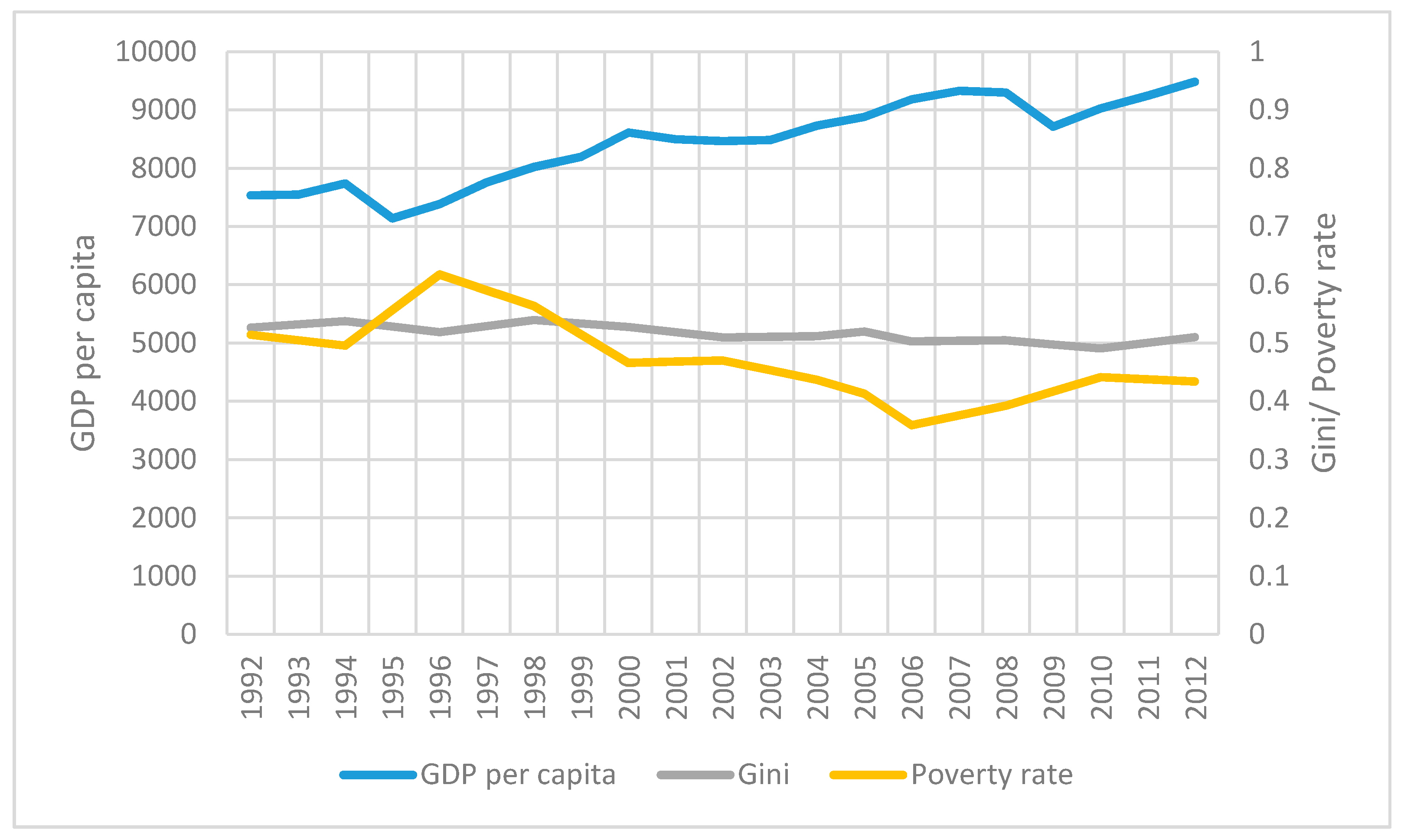
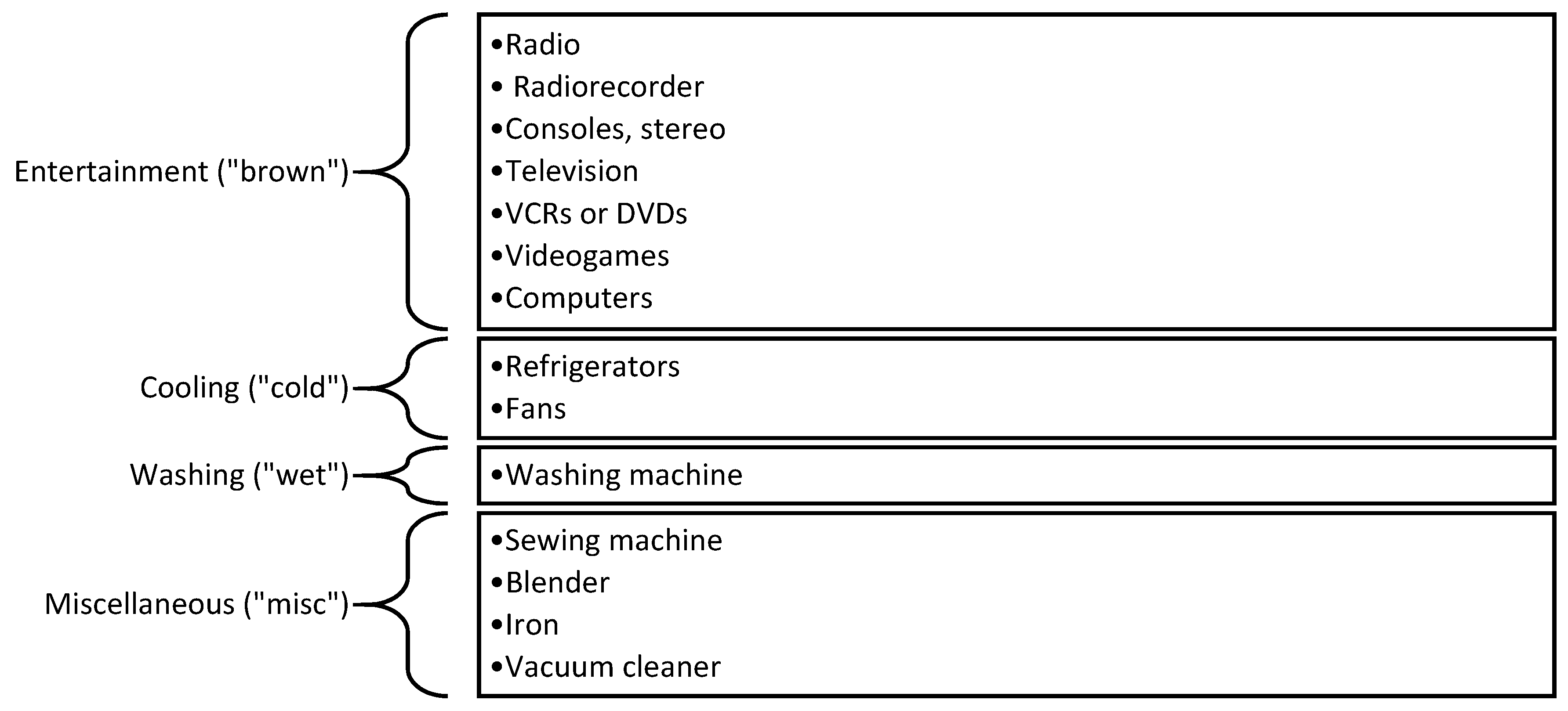
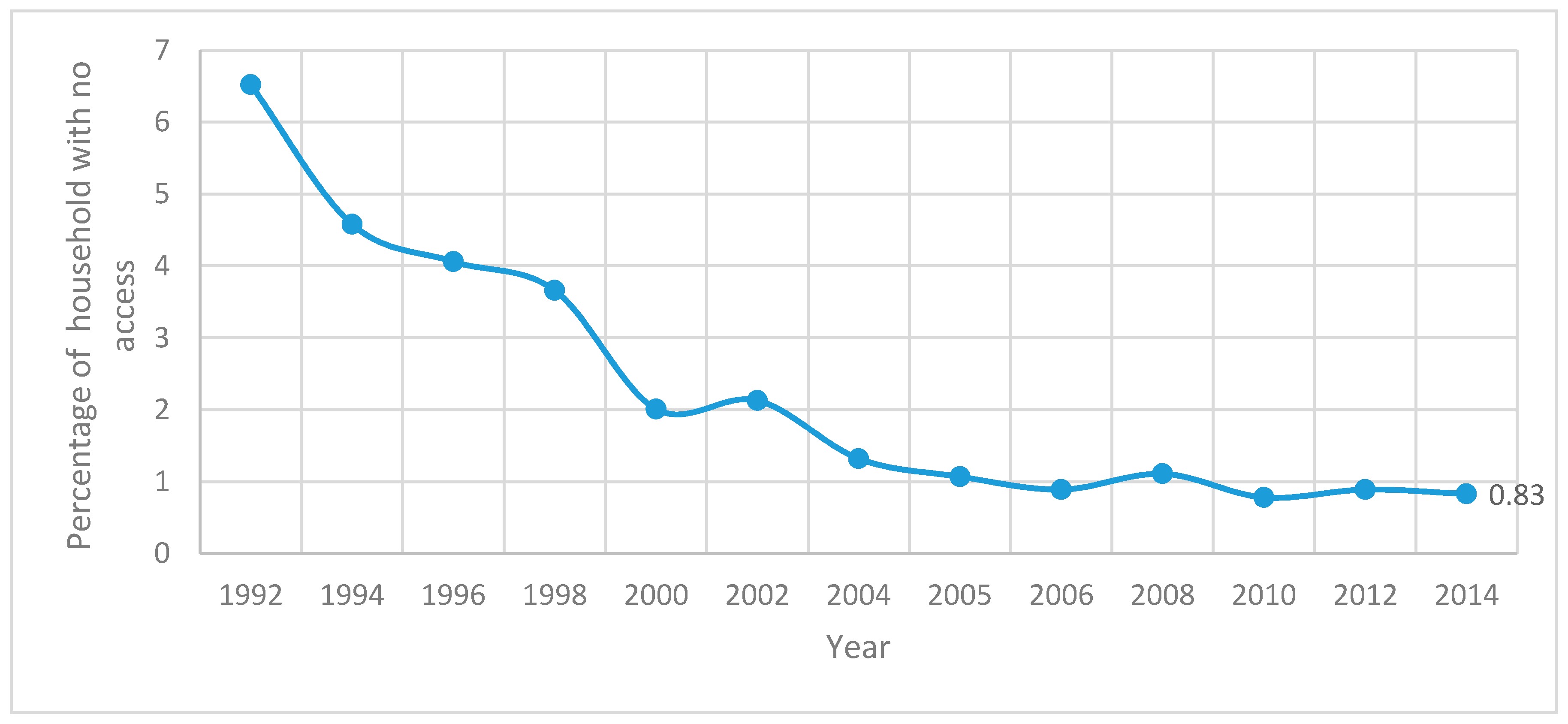
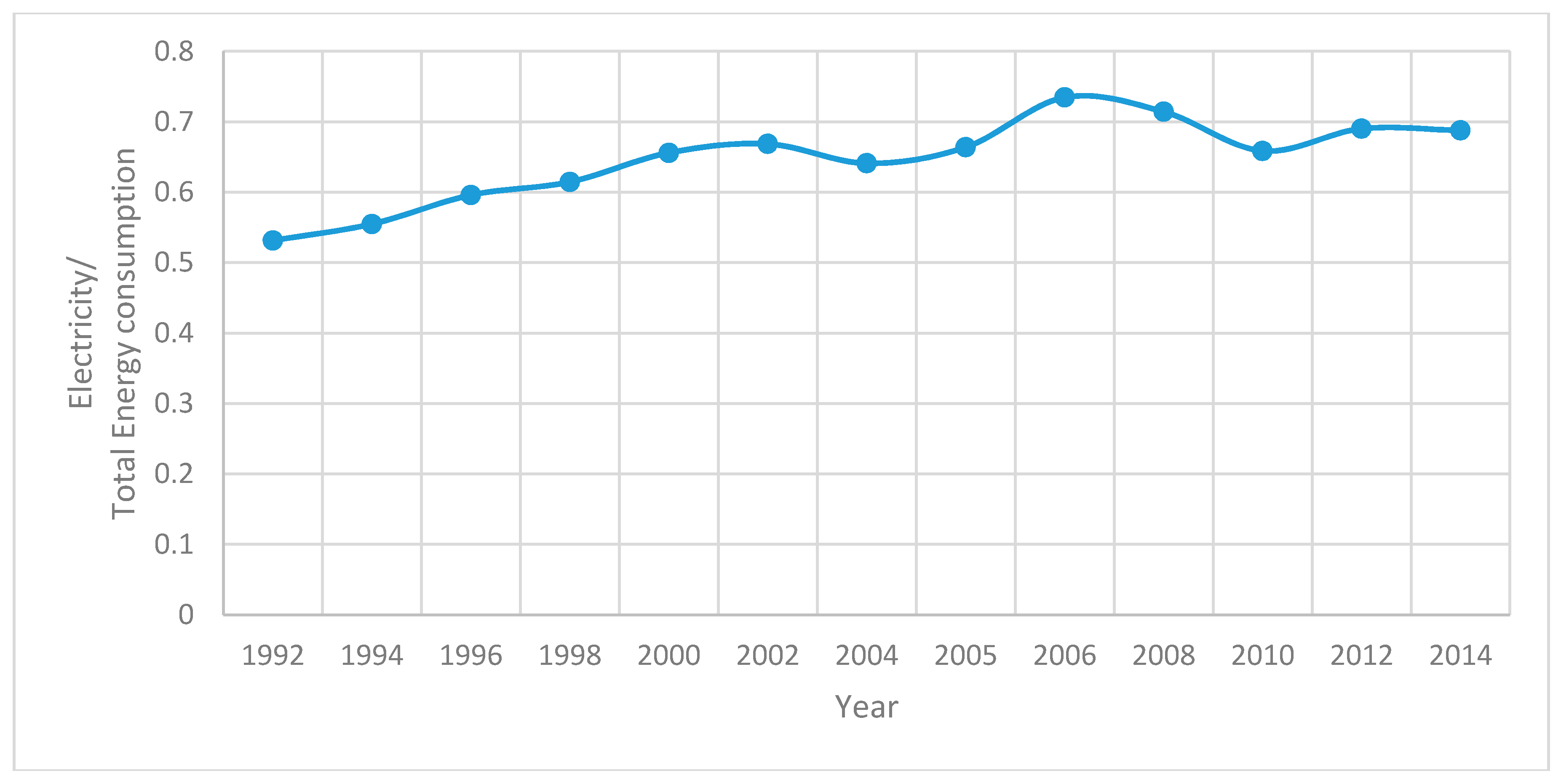
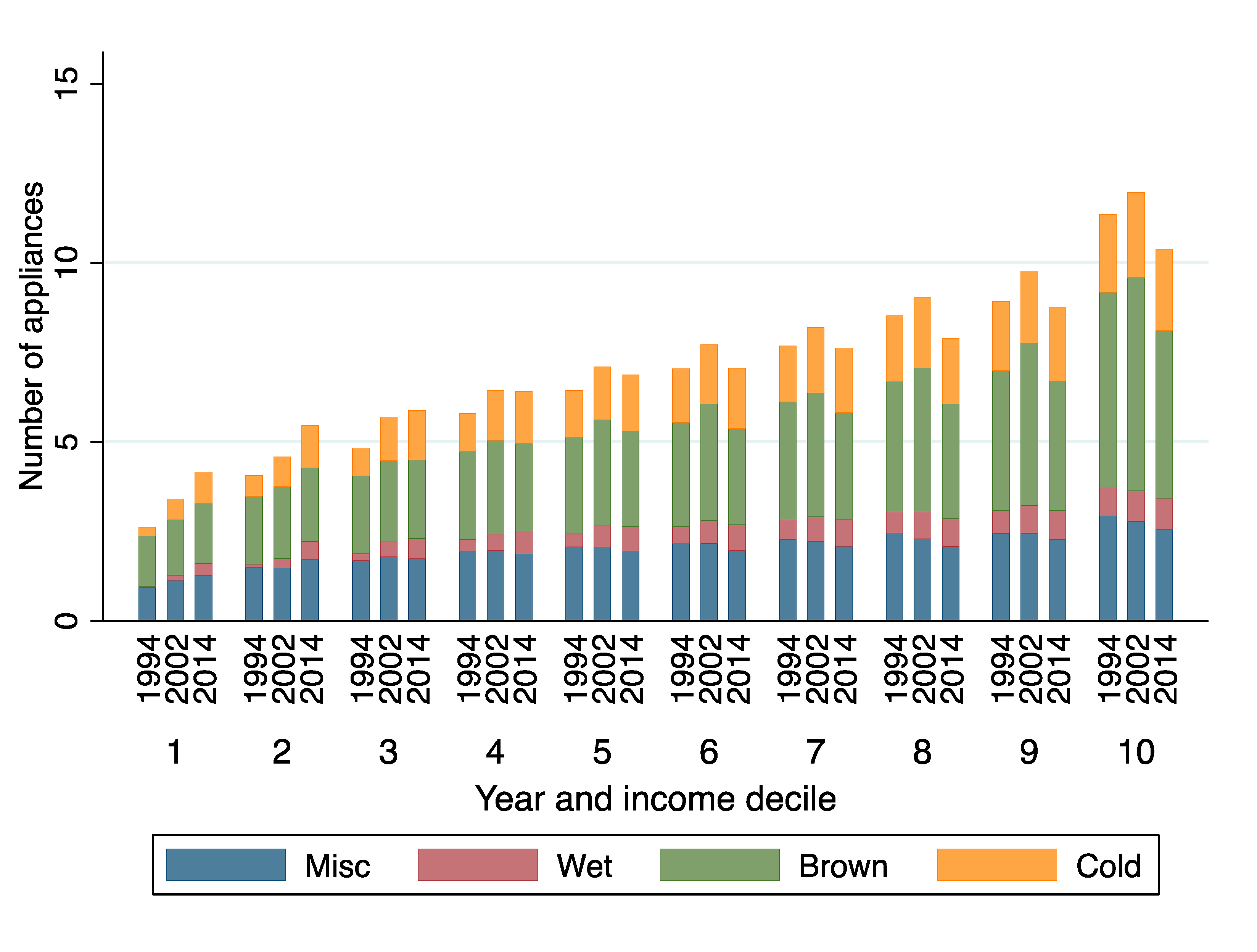
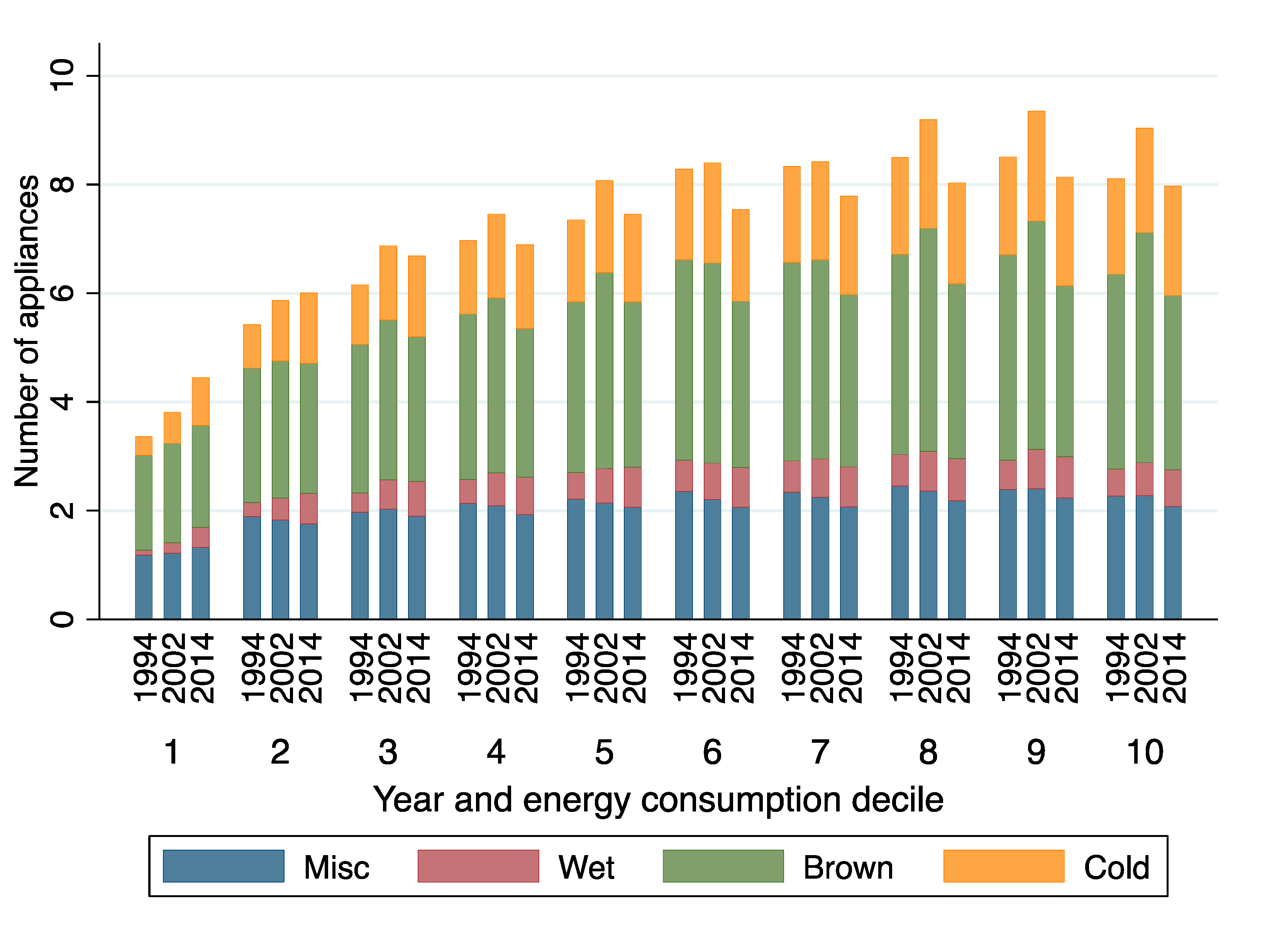
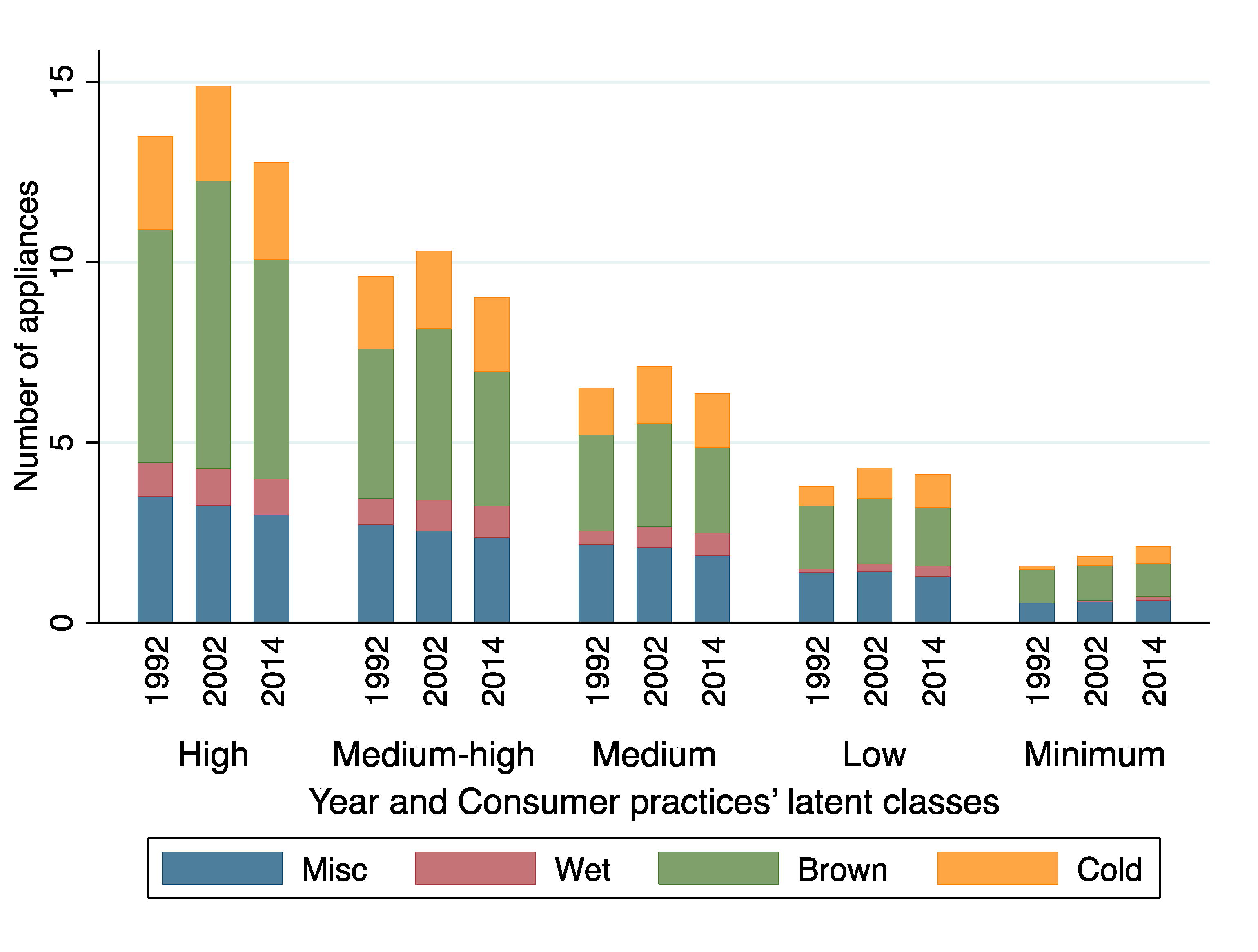
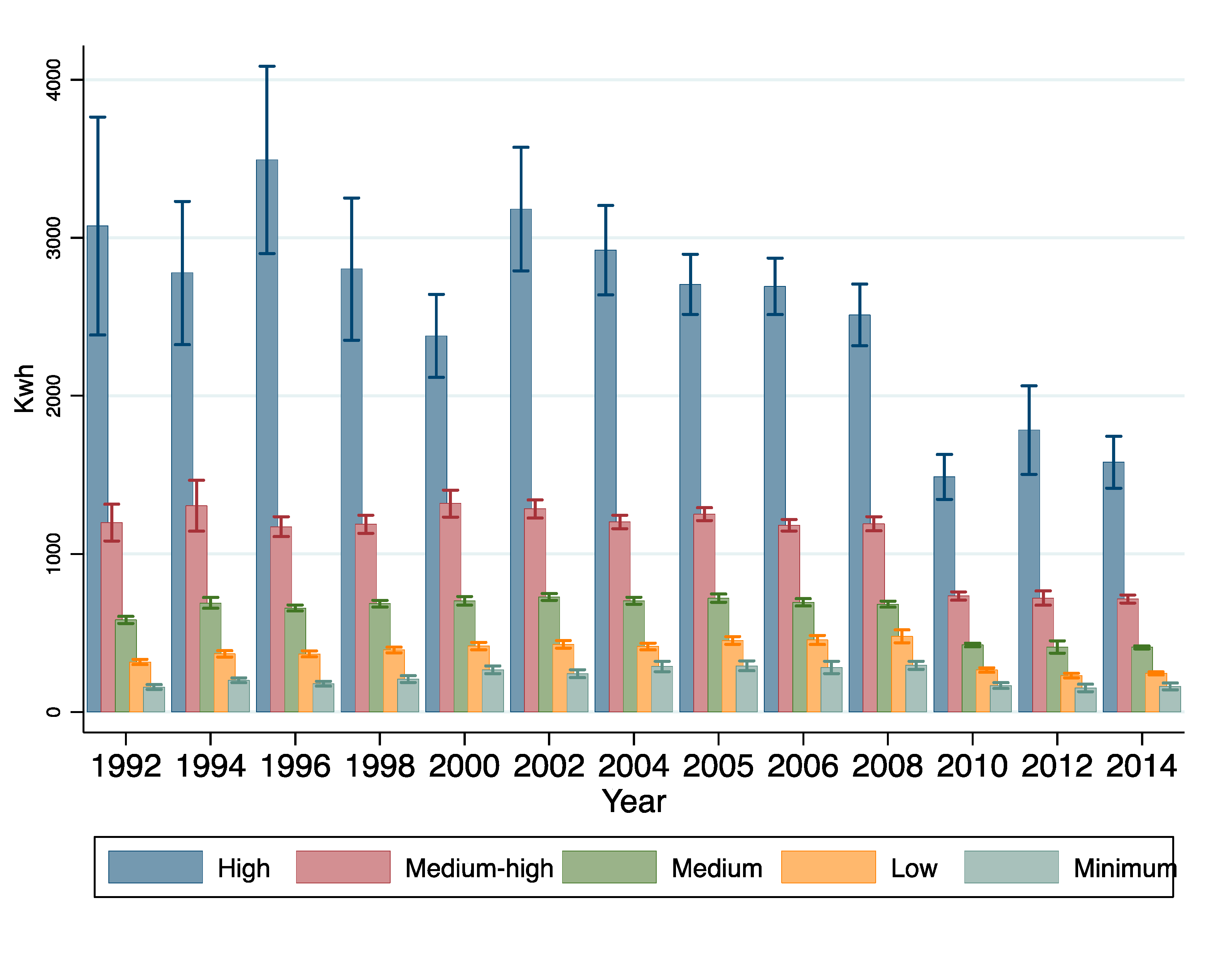

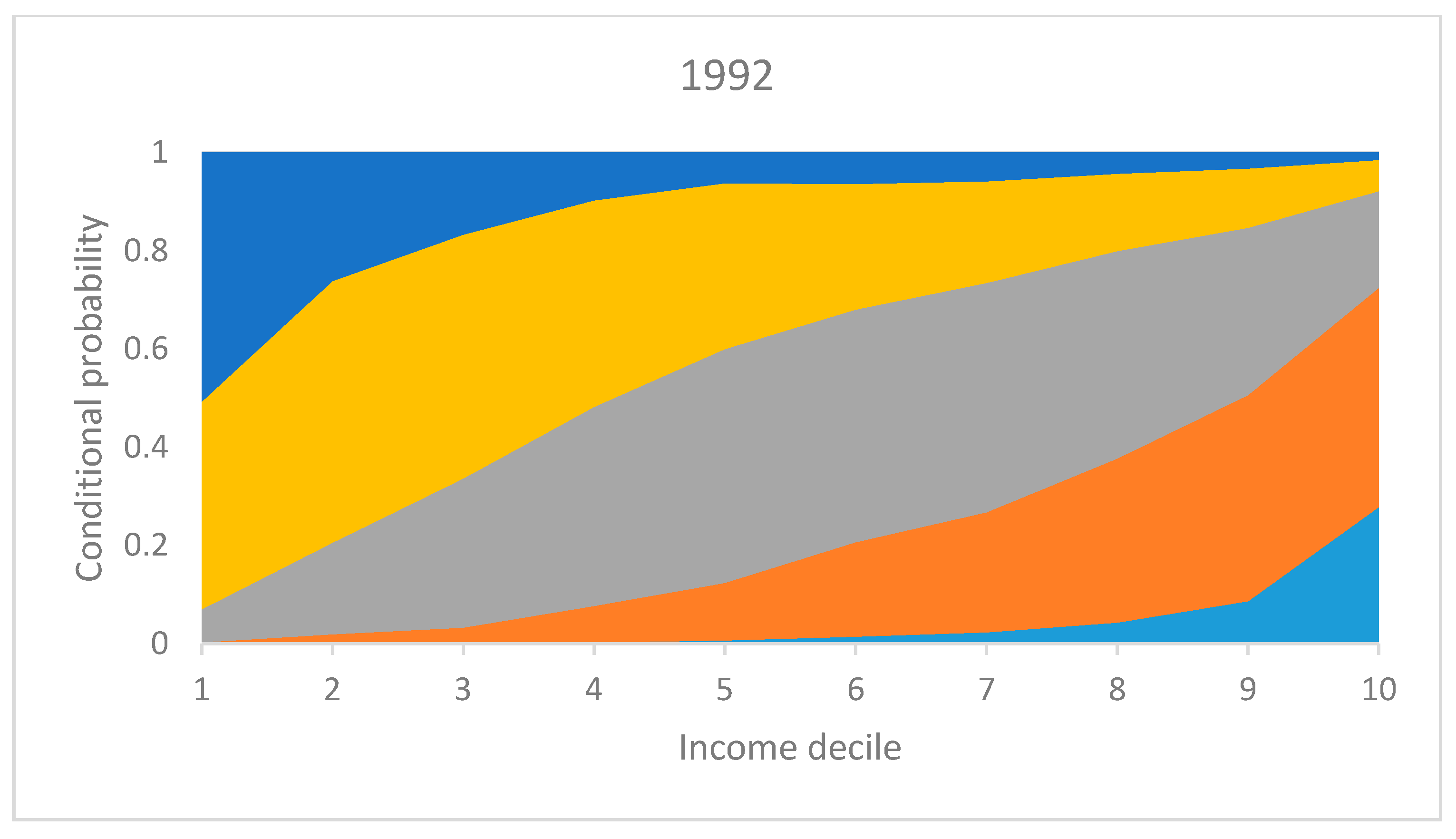
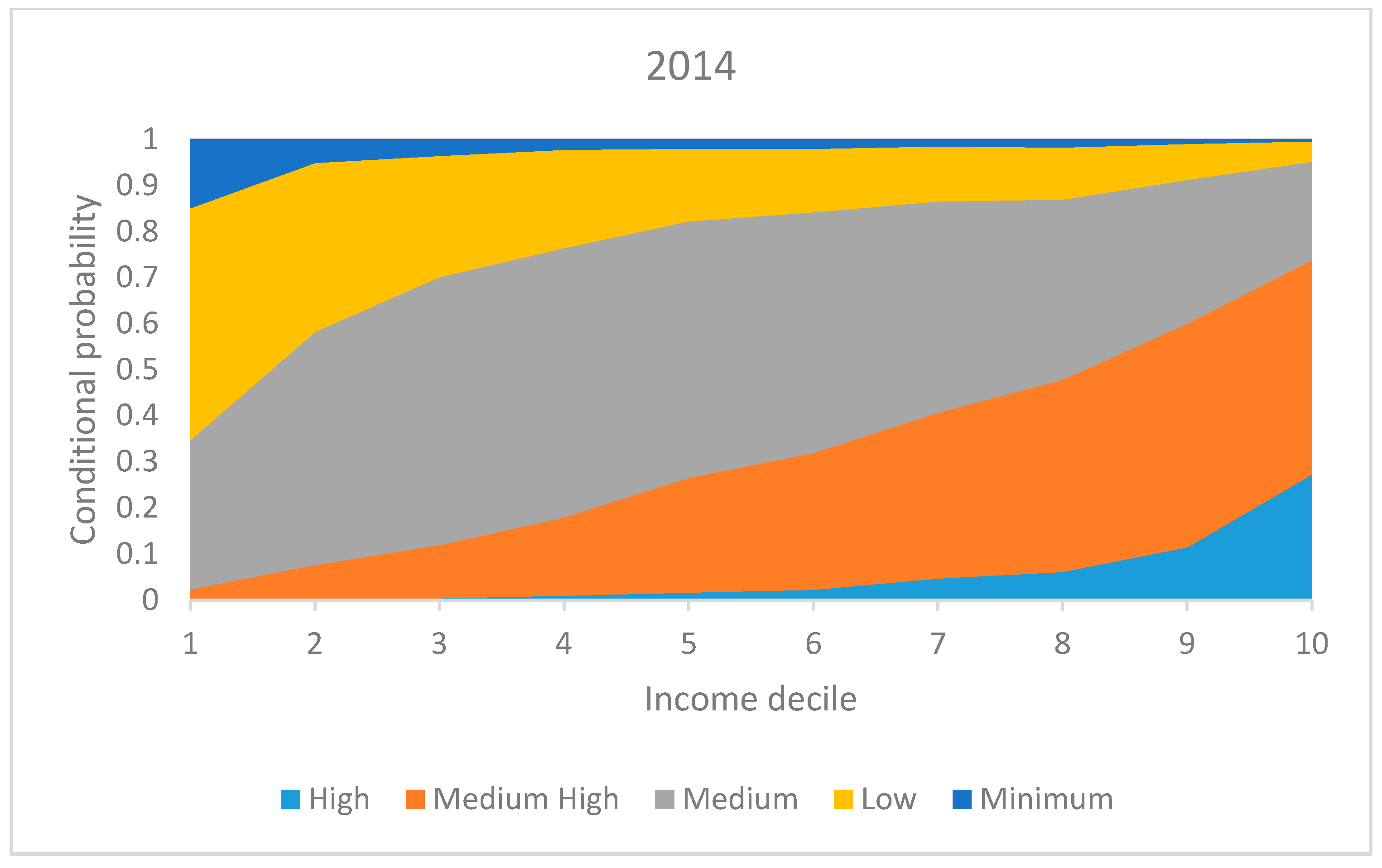
| Estimation | High | Medium High | Medium | Low | Minimum |
|---|---|---|---|---|---|
| Membership probability | 0.08 | 0.27 | 0.37 | 0.21 | 0.07 |
| Mean Appliances index | 3.64 | 2.42 | 1.64 | 0.87 | 0.18 |
© 2017 by the authors. Licensee MDPI, Basel, Switzerland. This article is an open access article distributed under the terms and conditions of the Creative Commons Attribution (CC BY) license (http://creativecommons.org/licenses/by/4.0/).
Share and Cite
Escoto Castillo, A.; Sánchez Peña, L. Diffusion of Electricity Consumption Practices in Mexico. Soc. Sci. 2017, 6, 144. https://doi.org/10.3390/socsci6040144
Escoto Castillo A, Sánchez Peña L. Diffusion of Electricity Consumption Practices in Mexico. Social Sciences. 2017; 6(4):144. https://doi.org/10.3390/socsci6040144
Chicago/Turabian StyleEscoto Castillo, Ana, and Landy Sánchez Peña. 2017. "Diffusion of Electricity Consumption Practices in Mexico" Social Sciences 6, no. 4: 144. https://doi.org/10.3390/socsci6040144





